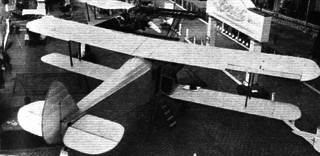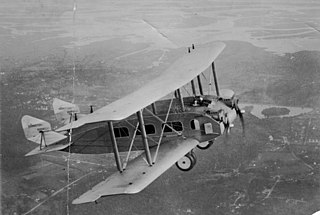Related Research Articles

The Sopwith T.1 Cuckoo was a British biplane torpedo bomber used by the Royal Naval Air Service (RNAS), and its successor organization, the Royal Air Force (RAF). The T.1 was the first landplane specifically designed for carrier operations, but it was completed too late for service in the First World War. After the Armistice, the T.1 was named the Cuckoo.

The Sopwith Tabloid and Sopwith Schneider (floatplane) were British biplanes, originally designed as sports aircraft and later adapted for military use. They were among the first successful types to be built by the Sopwith Aviation Company. The "Tabloid", so named because of its small size, caused a sensation when it made its first public appearance.

The Airspeed AS.6 Envoy was a twin-engined light transport aircraft designed and produced by the British aircraft manufacturer Airspeed Ltd.

The BAT F.K.26 was a British single-engined four-passenger biplane transport aircraft produced by British Aerial Transport Company Limited of London at the end of World War I.

The de Havilland DH.18 was a single-engined British biplane transport aircraft of the 1920s built by de Havilland.
The Sopwith Admiralty Type 807 was a 1910s British biplane seaplane designed and built for the Admiralty by the Sopwith Aviation Company.

The Sopwith Wallaby was a British single-engined long-range biplane built during 1919 by Sopwith Aviation Company at Kingston upon Thames.

The Short Silver Streak was the first British all-metal aircraft. It was designed and built by Short Brothers at Rochester, Kent, England. Although Flight magazine claimed that it was the first instance of stressed skin construction in the world, it was preceded by a number of Dornier designs, including the Dornier-Zeppelin D.I, which was ordered into production.

The Bristol Seely was entered into an Air Ministry competition for safe civil aeroplanes held in 1920. It was a single-engine biplane with accommodation for one passenger. After the competition, the single Seely was used as a testbed for the Bristol Jupiter engine development programme.

The Bristol Type 110A was a single-engine biplane for charter work, accommodating four passengers in comfort. Designed by Frank Barnwell and built at Filton Aerodrome by the Bristol Aeroplane Company. No orders were obtained and only one aircraft was built.
The Sopwith Grasshopper was a British two-seat touring biplane built by the Sopwith Aviation and Engineering Company at Kingston upon Thames in 1919.
The Sopwith Schneider of 1919 was a British racing seaplane. It was a single seat biplane intended to compete in the 1919 Schneider Trophy. After this race was abandoned due to fog, the Schneider was rebuilt into a landplane racer as the Sopwith Rainbow, being destroyed in a crash in 1923.

The Sopwith Atlantic was an experimental British long-range aircraft of 1919. It was a single-engined biplane that was designed and built to be the first aeroplane to cross the Atlantic Ocean non-stop. It took off on an attempt to cross the Atlantic from Newfoundland on 18 May 1919, but ditched during the flight owing to an overheating engine.
The Sopwith Buffalo was a British armoured fighter/reconnaissance aircraft of the First World War. A single-engined biplane, two examples of the Buffalo were built by Sopwith to carry out reconnaissance missions low over the trenches while protected against machine-gun fire from the ground, but no production followed, with the end of the war removing the need for such an aircraft.
The Sopwith Snark was a British prototype fighter aircraft designed and built towards the end of the First World War to replace the RAF's Sopwith Snipes. A single engined triplane, the Snark did not fly until after the end of the war, only three being built.
The Sopwith Three-seater was a British aircraft designed and built prior to the start of the First World War. One of the first aircraft built by the Sopwith Aviation Company, it was operated by both the Royal Naval Air Service (RNAS) and the Royal Flying Corps (RFC), being used briefly over Belgium by the RNAS following the start of the War.

The Sopwith Bat Boats were British flying boats designed and built from 1912 to 1914. A single-engined pusher biplane, the Bat Boat was the first successful flying boat and amphibious aircraft built in the United Kingdom, with examples used by the Royal Navy and by Greece and Germany.

The Burnelli RB-1 was a US twin engine biplane airliner prototype from 1920, incorporating a lifting body fuselage.
The Sopwith Sociable was a British single-engined two-seat tractor configuration biplane designed and built by Sopwith for the Royal Naval Air Service.
References
Notes
Bibliography
- "The Olympia Aero Show at a Glance". Flight, 8 July 1920, pp. 712–727.
- "The Olympia 1920 Aero Show". Flight, 22 July 1920, pp. 793–806.
- "The Air Ministry Competition at Martelsham: Some Notes on the Machines Entered". Flight , 5 August 1920, pp. 855–861.
- Jackson, A.J. British Civil Aircraft 1919–1972:Volume III. London:Putnam, 1988. ISBN 0-85177-818-6.
- Richardson, Bruce. Sopwith – The Man and His Aircraft. Letchworth, UK:Air Review, 1970. ISBN 0-900435-15-1.